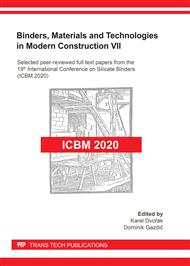[1]
A. Sassani, H. Ceylan, S. Kim, A. Arabzadeh, P.C. Taylor, K. Gopalakrishnan, Development of carbon fiber-modified electrically conductive concrete for implementation in Des Moines International Airport, Case Stud. Constr. Mater. 8 (2018) 277–291.
DOI: 10.1016/j.cscm.2018.02.003
Google Scholar
[2]
J. Wu, J. Liu, F. Yang, Three-phase composite conductive concrete for pavement deicing, Constr. Build. Mater. 75 (2015) 129–135.
DOI: 10.1016/j.conbuildmat.2014.11.004
Google Scholar
[3]
Amr S.El-Dieb; Mahmoud A.El-Ghareeb; Mohamed A.H. Abdel-Rahman; El Sayed A.Nasrd Multifunctional electrically conductive concrete using different fillers/Journal of Building Engineering, 15 (2018) 61-69.
DOI: 10.1016/j.jobe.2017.10.012
Google Scholar
[4]
Karla Hornbostel, Claus K. Larsen, Mette R. Geiker Relationship between concrete resistivity and corrosion rate – A literature review / Cement and Concrete Composites, 39 (2013) 60-72.
DOI: 10.1016/j.cemconcomp.2013.03.019
Google Scholar
[5]
Stark J., Wicht B. Concrete Durability/Translation from German, 1-th ed., RIA Quintet. Weimar, (2004).
Google Scholar
[6]
Yakovlev G.I., Grakhov V.P., Gordina A.F., Shaibadullina A.V., Saidova Z.S., Nikitina S.V., Begunova E.V., Elrefai A.E.M. Influence of carbon black dispersions on the properties of fine-grained concrete 8 (2018) 89–92.
Google Scholar
[7]
Urkhanova L.A., Buyantuev S.L., Urkhanova A.A., Lkhasaranov S.A., Ardashova G.R., Fediuk R.S., Svintsov A.P., Ivanov I.A. Mechanical and electrical properties of concrete modified by carbon nanoparticles // Magazine of Civil Engineering 8(92) (2019) 163–172.
Google Scholar
[8]
Hope BB, Ip AKC. Corrosion of steel in concrete made with slag cement. ACI Mater J 84(6) (1987) 525–531.
Google Scholar
[9]
Bazhenov U.M., Skoblenok G.L. Electrical properties of cement-polymer concrete // In the book: The use of polymer resins in concrete and reinforced concrete structures // Materials for the All-Union meeting. Vilnius (1971) 27-28.
Google Scholar
[10]
Bernatskii A. F., Tselebrovskii IU. N., Chunchin V.A. Electrical properties of concrete, Energiya, Moscow, (1980).
Google Scholar
[11]
Erman Demirciliog˘lu, EgemenTeomete, Erik Schlangen, F. Javier Baeza Temperature and moisture effects on electrical resistance and strain sensitivity of smart concrete / Construction and Building Materials, 224 (2019) 420-427.
DOI: 10.1016/j.conbuildmat.2019.07.091
Google Scholar
[12]
Heydar Dehghanpour, Kemalettin Yilmaz, MetinIpek Evaluation of recycled nano carbon black and waste erosion wires in electrically conductive concretes / Construction and Building Materials, 221 (2019) 109-121.
DOI: 10.1016/j.conbuildmat.2019.06.025
Google Scholar
[13]
Menkovsky M.A., Yavorsky V.T. Technology of sulfur, Chemistry, Moscow, (1985).
Google Scholar
[14]
Paturoev V.V. Polymer concrete, Research Institute of Concrete and Reinforced Concrete, Stroyizdat, Moscow, (1987).
Google Scholar
[15]
Milica M. Vlahovic, Sanja P. Martinovic, Tamara Dj. Boljanac, Predrag B. Jovanic, Tatjana D. Volkov-Husovic Durability of sulfur concrete in various aggressive environments / Construction and Building Materials 25 (2011) 3926–3934.
DOI: 10.1016/j.conbuildmat.2011.04.024
Google Scholar
[16]
Korolev E.V., Proshin A.P., Bazhenov U.M., Sokolova U.A. Radiation-protective and corrosion-proof sulfuric construction materials, Paleotip, Moscow, (2006).
Google Scholar
[17]
Bernatskii A.F. Electrical insulating concrete. Properties, technology, application, Concrete and reinforced concrete in the third millennium, Proceedings of the international scientific and practical conference, Rostov-on-Don, (2000).
Google Scholar
[18]
Gumeniuk A., Hela R., Polyanskikh I., Gordina A., Yakovlev G. Durability of concrete with man-made thermoplastic sulfur additive, IOP Conference Series: Materials Science and Engineering. (2020) 032012.
DOI: 10.1088/1757-899x/869/3/032012
Google Scholar
[19]
Russian State Standard GOST 8736-2014.
Google Scholar
[20]
Russian State Standard GOST 127.1-93.
Google Scholar
[21]
Quality passport № 448N Sulfur technical gas granulated, grade 9998.
Google Scholar


